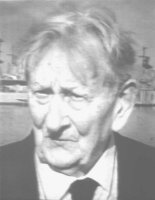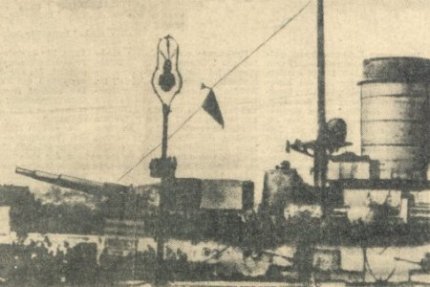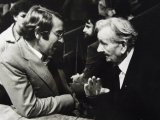Homepage Renate and Klaus Kuhl - Sailors' revolt in Kiel
Sailors's revolt in Kiel
Igniting the November Revolution 1918 in Germany
 Lothar Popp ca. 1974 |
Popp talking with Norbert Gansel 1978; click to magnify. |
Interview with Lothar Popp 1978 (extractions):
At 28 October 1918 the open sea-fleet received order to leave the ports. The sailors were sure that their officers wanted the fleet to rather sink in a last despair-fight than being surrendered in the ceasefire-negotiations with the Allied Forces. The stokers pulled out the fires and prevented the movement of the ships.
Delegations of the sailors explained, they are ready to defend the coast against an attack, but they are not ready to die in a senseless perdition. Cirka 800 men were arrested .... (1)
Since meetings were not allowed, the marines began to demonstrate. At five o'clock in the afternoon of November 3rd, approximately ten thousand marines and some thousand workers gathered, thereafter moved to the "Waldwiese" and freed men who were imprisoned there; a considerable number armed themselves.
The demonstration moved to the military-prison in the "Feldstrasse". Navy-infantry, sent to stop the mass, refused orders. However at the "Feldstrasse", a clash occured with a group, that was extra composed as applicants and mates. There were eight dead people and twenty casualties (see footnote below). However the movement could not be intercepted any longer. More and more units joined in. Soldatenräte (soldier's councils) were established.
In each of the barracks revolution was made seperately, also on each ship. From one ship they came to call me. They came, I should go with them on board. Thinking it over nowadays: I enter such a boat, the next officer comes and shoots you. It's great this didn't happen that time. Imagine, I get on board, I tell the commandant to have the crew lined up and he obeyed! This was on board of the "Bayern", a huge ship. I made a speech, they hoisted the Red Flag and that was that. (In another interview Popp remarked: ... I spoke to the commander afterwards, he was also „fed up to the back teeth“.)
 |
On a battle cruiser of
the high sea fleet the Red Flag is hoisted. From "Junge
Welt", (1968) |
Concerning the question as to why Noske was given relatively free hand in Kiel
Kuhl: Kuhl: I cannot understand this, this has always been a puzzle to me: Noske came, to strangle the revolution. (Popp: yes but he did not manage.), but why is he then elected chairman of the soldier's council?
Popp: Who was the soldier's council, they hardly knew one another. This were not necessarily politically oriented people. I also made a mistake that time, there was a soldier whom I knew personally. I called him and he was also elected. That was the biggest lunacy ever happened, that was a gruesome man. We hardly knew one another. There was no talking about it. I don't even know how many soldier's councils were established that time. There in that corner they elected one, another one there, another one there. The real soldier's councils, well structured, they came into being after I had organized for it. These were wild stories.
Kuhl: Did you try to prevent Noske being elected?
Popp: Why that? I could not exclude the SPD! Listen! You try just being one and the others are ten, you want to exclude those ten? How would you do that?
Kuhl: One could try at least.
Popp: No, that is raising, man alive!
This question (as to why the councils allowed Noske into a leading position) was also answered by Karl Artelt in lectures to members of the Volksmarine (navy in the GDR). See >>
The full interview text (mostly German) can be viewed or downloaded here (pdf, 1350 kB): >>
Annotation:
1: Popp remarked that the prisoners were brought to Kiel. This
could not be substantiated. Dirk Dähnhardt's study (Revolution
in Kiel, 1978, p. 109) showed that the Wilhelmshaven prisoners
were brought into a prison in Bremen-Oslebshausen and they were
freed after the sailors' revolt in Kiel by sailors from Kiel.
Daehnhardt refers to publications from Peter Kuckuk and Ulrich
Kluge. Brought to Kiel were only those 47 "ring leadres" arrested
during the passage through the Nord-Ostsee-Kanal, as well as those
57 additionally arrested in the morning of the 3 November from
the "Markgraf".
Dähnhardt spricht von 47 Verhafteten (Dähnhardt, Revolution
in Kiel, S. 54) und gibt als Quelle Bundesarchiv-Militärarchiv
F 4077/64921 an. Es handelt sich nach neuer Signatur um RM 8/1022
und die Angaben befinden sich auf Blatt 257. Danach wurden 23
Heizer, die die Arbeit am Kessel verweigerten, 20 Matrosen, die
sich weigerten anzutreten und 5 vermutete Rädelsführer
verhaftet und dann in Arrestanstalten an Land gebracht. Vermutlich
hat sich Dähnhardt bei der Anzahl geirrt. (Frdl. Hinweis
von Dr. C. Lübcke.)
2: Regarding the number of dead and casualties see Dähnhardt:
"Revolution in Kiel", Wachholtz Verlag, 1978, pages 65 and 66;
according to official documents there were 7 people shot dead.
There were no women nor children among the casualties. One woman
had died a short time before within the demonstration when she
was run over by a tram. Two of the wounded died some days later.
Thus altogether 10 people died in connection with incidence of
the 3rd November.
Volker Ullrich's and Dirk Dänhardt's interviews with Lothar Popp
For his thesis about the worker's movement in Hamburg Dr. Volker
Ullrich conducted an interview with Lothar Popp in 1970. Two years
later another talk followed. Unfortunately there are no records
available except written notes by Dr. Ullrich, which are kept
at the Hamburg Forschungsstelle für Zeitgeschichte.
Dr. Dirk Dähnhardt interviewed Lothar Popp in 1975 for his
thesis on the sailors' revolt in Kiel. There are also no records
available except notes, written and typed afterwards. They were
made available by his wife Ursula Dähnhardt.
Both can be viewed or downloaded here (German, pdf, 110 kB) >>
Updated 14 Aug. 2018



